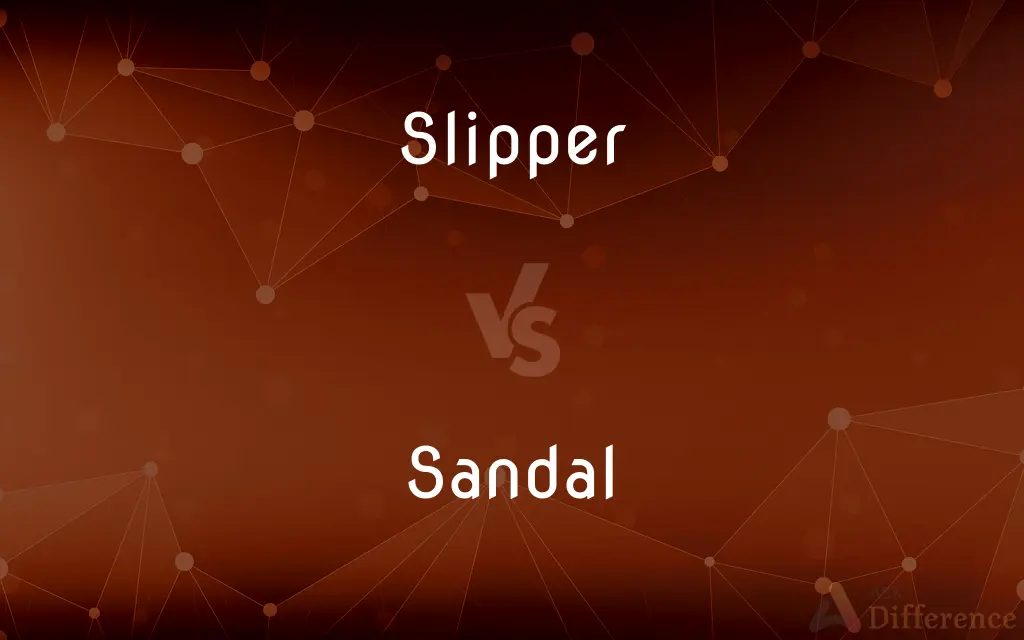Slipper vs. Sandal — What's the Difference?
Edited by Tayyaba Rehman — By Urooj Arif — Updated on March 24, 2024
Slippers are lightweight, comfortable footwear designed primarily for indoor use, offering warmth and softness, whereas sandals are open footwear with straps, suitable for outdoor use, allowing air flow to keep feet cool.

Difference Between Slipper and Sandal
Table of Contents
ADVERTISEMENT
Key Differences
Slippers are a type of footwear that prioritize comfort and warmth, often made with soft materials like plush or wool, and typically worn indoors. They are designed to be easily slipped on and off, providing convenience and a cozy feeling for the wearer. Sandals, on the other hand, are constructed for outdoor wear with a sole held to the foot by straps passing over the instep and sometimes around the ankle. They are made from a variety of materials, including leather and synthetic materials, and are favored in warm climates for their breathability and the freedom they offer to the feet.
The design of slippers focuses on softness and warmth, making them ideal for cold floors and relaxing at home. They may come with or without a hard sole, with the softer versions being perfect for bedroom use. Sandals are designed for ventilation and ease of use in outdoor settings, from casual outings to more active environments, and their construction often includes supportive footbeds, arch support, and adjustable straps for a secure fit.
Slippers can range from simple designs intended for basic comfort to more luxurious options featuring memory foam or supportive insoles for added foot support. Sandals, while also varying widely in design, often incorporate features aimed at prolonged wear and outdoor activities, such as cushioned soles, water-resistant materials, and durability for walking and exploring.
Slippers play a role in home life and hospitality in many societies, symbolizing comfort and relaxation. Sandals have a rich history too, being one of the oldest forms of footwear known to humanity, with their open design allowing for cooling in hot climates. This makes them a staple in summer wardrobes and in regions with warmer weather year-round.
While both slippers and sandals offer specific benefits for foot comfort and protection, their primary differences lie in their intended use, construction, and materials, reflecting their adaptation to indoor versus outdoor environments and varying climatic conditions.
ADVERTISEMENT
Comparison Chart
Intended Use
Primarily indoor comfort and warmth
Outdoor wear, suitable for warm climates
Design Focus
Softness, warmth, ease of slipping on/off
Ventilation, foot freedom, and durability
Materials
Plush, wool, soft synthetic fabrics
Leather, rubber, synthetic materials
Sole Type
Soft sole for indoor, hard sole for mixed use
Durable sole for outdoor terrain
Cultural Aspect
Symbolizes home comfort and relaxation
Ancient footwear form, suited for heat
Varieties
Simple to luxurious designs for comfort
Designed for casual to active use
Key Features
Soft, warm, comfortable for indoor use
Breathable, open design, for outdoor use
Compare with Definitions
Slipper
Designed for easy on and off.
The hotel provided slippers for guests to easily slip on after a bath.
Sandal
Features like arch support for extended wear.
The sandals’ arch support made sightseeing all day comfortable.
Slipper
A soft, comfortable indoor shoe.
She put on her slippers and curled up with a book by the fireplace.
Sandal
Open footwear with straps for outdoor use.
He wore his sandals on the beach to keep his feet cool.
Slipper
Often made of soft materials for warmth.
His wool slippers kept his feet warm all winter.
Sandal
Made with materials like leather or synthetic.
The leather sandals matched perfectly with her outfit.
Slipper
Can have a soft or hard sole.
She preferred slippers with a hard sole for stepping outside.
Sandal
Ancient form of footwear for hot climates.
Sandals have been worn since ancient times to combat the heat.
Slipper
Symbol of relaxation and home.
Coming home and putting on slippers is her favorite part of the day.
Sandal
Suitable for warm weather and ventilation.
Her sandals were perfect for walking around the city in summer.
Slipper
Slippers are light footwear that are easy to put on and off and are intended to be worn indoors, particularly at home. They provide comfort and protection for the feet when walking indoors.
Sandal
Sandals are an open type of footwear, consisting of a sole held to the wearer's foot by straps going over the instep and around the ankle. Sandals can also have a heel.
Slipper
A comfortable slip-on shoe that is worn indoors.
Sandal
A shoe consisting of a sole fastened to the foot by thongs or straps.
Slipper
Beat (someone) with a slipper
He didn't slipper me hard
Sandal
A low-cut shoe fastened to the foot by an ankle strap.
Slipper
A low shoe that can be slipped on and off easily and is usually worn indoors.
Sandal
A rubber overshoe cut very low and covering little more than the sole of the shoe.
Slipper
A low soft shoe that can be slipped on and off easily.
Sandal
A strap or band for fastening a low shoe or slipper on the foot.
Slipper
Such a shoe intended for indoor use; a bedroom or house slipper.
Get out of bed, put on your slippers, and come downstairs.
Sandal
Sandalwood.
Slipper
A flip-flop (type of rubber sandal).
Sandal
A type of open shoe made up of straps or bands holding a sole to the foot
Slipper
A person who slips.
Sandal
Sandalwood
Slipper
A kind of apron or pinafore for children.
Sandal
A long narrow boat used on the Barbary coast.
Slipper
A kind of brake or shoe for a wagon wheel.
Sandal
Same as Sendal.
Sails of silk and ropes of sandal.
Slipper
(engineering) A piece, usually a plate, applied to a sliding piece, to receive wear and permit adjustment; a gib.
Sandal
Sandalwood.
Slipper
A form of corporal punishment where the buttocks are repeatedly struck with a plimsoll; "the slipper".
Sandal
A kind of shoe consisting of a sole strapped to the foot; a protection for the foot, covering its lower surface, but not its upper.
Slipper
(euphemism) The plimsoll or gym shoe used in this form of punishment.
Sandal
A shoe consisting of a sole fastened by straps to the foot
Slipper
(medicine) A kind of bedpan urinal shaped like a shoe.
Slipper
(obsolete) slippery
Slipper
To spank with a plimsoll as corporal punishment.
Slipper
One who, or that which, slips.
Slipper
A kind of light shoe, which may be slipped on with ease, and worn in undress; a slipshoe.
Slipper
A kind of apron or pinafore for children.
Slipper
A kind of brake or shoe for a wagon wheel.
Slipper
A piece, usually a plate, applied to a sliding piece, to receive wear and afford a means of adjustment; - also called shoe, and gib.
Slipper
Slippery.
O! trustless state of earthly things, and slipper hopeOf mortal men.
Slipper
Low footwear that can be slipped on and off easily; usually worn indoors
Slipper
A person who slips or slides because of loss of traction
Common Curiosities
What distinguishes a sandal from other footwear?
Sandals are open, strapped footwear suitable for outdoor use, especially in warm weather.
What are slippers?
Footwear designed for indoor use, emphasizing comfort and warmth.
Can slippers be worn outdoors?
While primarily for indoor use, some slippers with hard soles can be worn for short outdoor trips.
Can sandals provide sufficient foot support?
Many sandals are designed with supportive features like cushioned footbeds and arch support for comfort and stability.
Why are sandals popular in summer?
Their open design allows for air circulation, keeping feet cool in hot temperatures.
Is it culturally acceptable to wear slippers outside the home in some places?
In some cultures, wearing slippers outside is common, while in others, it is reserved for home use.
How do I choose between slippers and sandals?
Consider the intended use: slippers for indoor comfort and warmth, sandals for outdoor activities in warm weather.
Why might someone choose slippers over other indoor footwear?
For their ease of use, warmth, and comfort, especially in colder climates or on cold floors.
What is the significance of sandals in history?
Sandals are among the oldest known types of footwear, with a significant historical presence in many cultures due to their practicality in warm climates.
Can both slippers and sandals be fashionable?
Yes, both can be designed with fashion in mind, ranging from casual to luxurious styles.
What role do slippers play in home comfort?
Slippers contribute significantly to the sense of home comfort and relaxation, providing warmth and softness underfoot.
Are there slippers designed for foot health?
Yes, some slippers are designed with supportive insoles and materials for foot health.
What materials are sandals typically made from?
Leather, rubber, and various synthetic materials for durability and comfort.
How should I care for leather sandals?
Leather sandals should be regularly cleaned and conditioned to maintain their appearance and longevity.
How have sandals evolved over time?
Sandals have evolved from simple ancient designs to modern styles incorporating advanced materials and ergonomic features.
Share Your Discovery

Previous Comparison
Signature vs. Holograph
Next Comparison
Canal vs. ForamenAuthor Spotlight
Written by
Urooj ArifUrooj is a skilled content writer at Ask Difference, known for her exceptional ability to simplify complex topics into engaging and informative content. With a passion for research and a flair for clear, concise writing, she consistently delivers articles that resonate with our diverse audience.
Edited by
Tayyaba RehmanTayyaba Rehman is a distinguished writer, currently serving as a primary contributor to askdifference.com. As a researcher in semantics and etymology, Tayyaba's passion for the complexity of languages and their distinctions has found a perfect home on the platform. Tayyaba delves into the intricacies of language, distinguishing between commonly confused words and phrases, thereby providing clarity for readers worldwide.














































